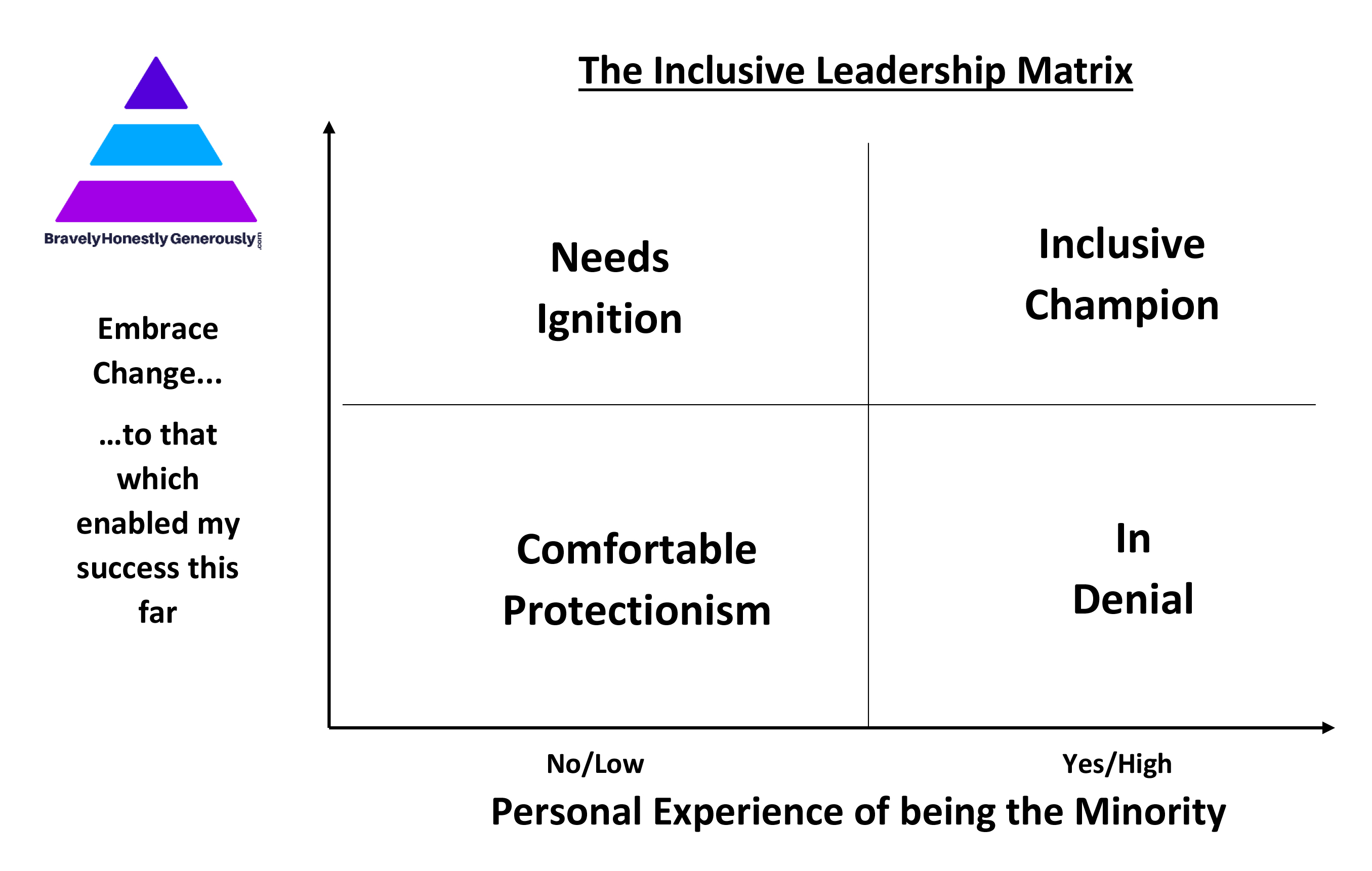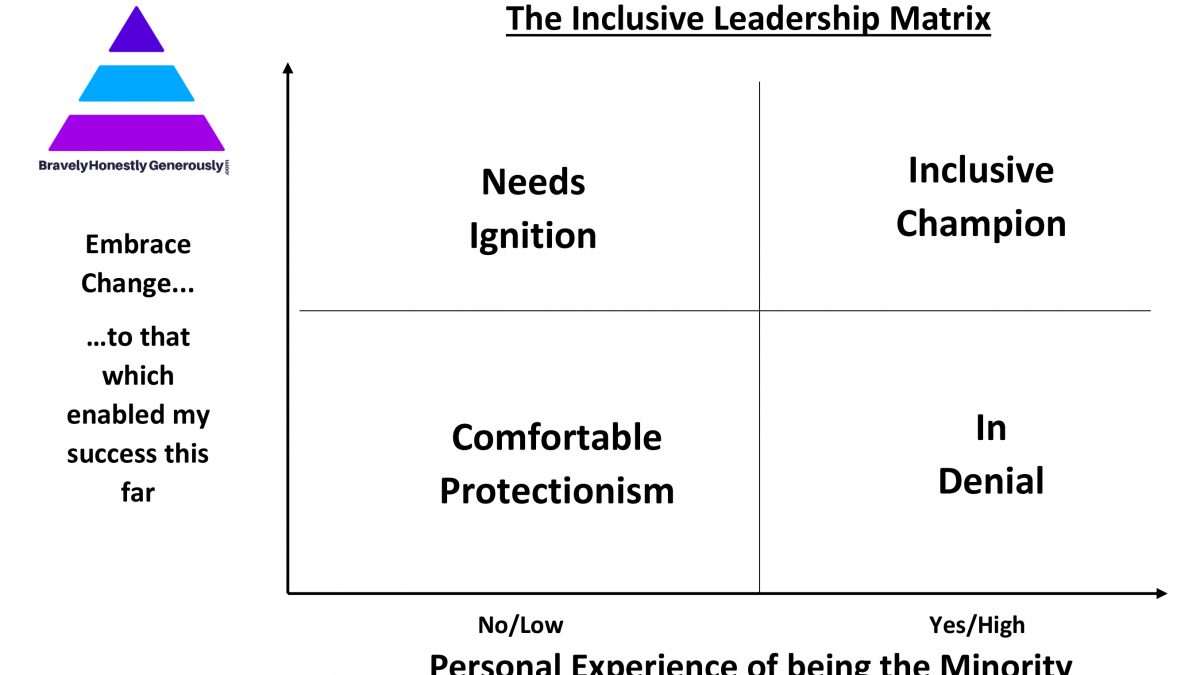The Inclusive Leadership Matrix – how Leaders become Champions

We get the team we deserve!
January 10, 2019
Diversity: You can’t outsource Empathy!
March 22, 2019It is now widely accepted that organisations which embrace diversity, attract & retain talent, have greater employee engagement and have better business performance. Yet in some areas of business, the leadership & culture seem slow to evolve and become more diverse & inclusive. Instead we often hear from employees who feel that their leaders ‘say the right thing’, but actually do little to deliver tangible change. How can that be, and what can we do to help leaders move with more pace? There are many factors which enable increased organizational inclusivity and diversity, including clear policies & training, transparent data on population actuals and targets, flexible working and so on. The key to unlock these tools is genuine Leadership Commitment, which leads to behavioural change. So in organisations where progress is slow, perhaps the question to explore is whether the leaders are really committed? And if not, what could be getting in the way of that commitment?
There are of course significant challenges faced by modern day business leaders – a volatile, relentless, high pressure world, with too many priorities, too many stakeholders, and not enough time or resources to do all the things we need to do. We must acknowledge this & recognize that the very real ‘cognitive overload’ experienced by many leaders makes it really hard to drive all the changes that they would like to. However, the case for diversity & inclusion is powerful, and indeed promises to deliver better culture and better results, the very answers to our over-stretched leadership lives.
So what is going on?
An answer comes when we look at 2 axes: * Embracing Change, to that which enabled my success this far * Personal Experience of being the Minority
We know that embracing change is a necessity for leadership success these days, so why raise it here? It is the specific aspect of change that matters in this context. We are not talking here about embracing digital disruption or retail revolution or political uncertainty; we are talking about ‘change to that which has enabled my success this far’ – where ‘that’ might be a homogeneous leadership culture – people mostly of the same gender, colour, sexuality, nationality, social background, neuro-typical and physically typical.
That homogeneity has been comfortable and enjoyable for those within, the unwritten ‘rules’ work for ‘how things get done around here’, and there is no explicit bias. For many of us, it is really hard to embrace the need to change the very culture which has enabled our personal success and indeed which we have helped create. It can feel like denying some aspects of our past, of ourselves, and it requires us to go forward into an uncertain future were it is likely we will have less control. Personal experience of being the minority is key to really feel and understand what it is like.
Without this experience, leaders often underestimate the obstacles confronting diverse employees, and perceive a workplace with far less bias than actually exists. When you have lived or worked in a group where you are the only person of your gender, or colour, or nationality, or sexuality, or social background, then you have experienced what it feels like to be the minority. You hear the ‘harmless comments & jokes’ about your group, you experience the stereotyping, you sense there are rules and norms which you don’t understand. You want to ask about things, yet to have to ask will show exactly that you are not ‘one of us’.
You feel uncertain of yourself and that you probably ‘don’t belong here’. Once you have had that experience, you much better understand the challenges faced by people in the minority in your organization. When we plot these two factors we arrive at 4 types of leadership behavior regards commitment to inclusion & diversity, and we can see these in the graphic.
Let’s expand each of the behaviours and some ideas how we can help leaders to build their commitment to inclusion & diversity:
Inclusive Champion: Leaders who are high on Embraces Change and have had personal experience of bring the Minority, have a good likelihood to be Inclusive Champions. They know how it feels, and they don’t want their people to have to feel it. Rather they want a workplace that reflects the diversity of society, where people behave inclusively, all people are valued for who they are. They recognise that the work culture of the future may not be how it was in the past, and while leading into the unknown is scary, they know it is the right thing to do. So they embrace it passionately and lead from the front – not as a cause, not as a cost, but as a way to do better business by doing the right thing.
Needs Ignition: Here we have leaders who recognize the need to change, they understand that something needs to be done, and they are willing to stand up and lead the way. However they don’t really feel it. When they talk about diversity they don’t sound passionate in the way they do when they talk about some other topics. The reason is they have not been in the minority themselves, they have not felt it. One way to help these leaders to feel it as well as understand it, is for them to have a genuine minority experience. Work in a team where they are the only person of their gender, or colour or sexuality or nationality. Go and do it for a month out. Or a day a week. Or join a volunteer group requiring some time in the evenings / nights / weekend. The experience could be the spark that ignites the rational understanding with the emotional passion to become an inclusive champion.
In Denial: Leaders who have indeed had experience of being the minority and so do know how it feels – how it holds them back. The feelings weren’t nice, and they would prefer not to think about it. They have worked hard to get to their position of leadership and they like it. They lead a good culture. They do and say the right things. They don’t want to give up the way things are. There are enough challenges & initiatives to handle. ‘I am making a start on this, but the bigger journey on diversity can be dealt with by the next leader’. In this case, the answer could be for someone who knows the leader really well, to get them to re-access the feelings they had when they were in the minority; and confront themselves with the reality that there are people in their company now having these feelings, while the leader has the power to drive change and help all to feel included.
Comfortable Protectionism: Here we have leaders who have not experienced being a minority and so tend not to perceive bias or obstacles for minority people; and who are comfortable in the homogenous culture which has served them well over the years and indeed they helped create. Leaders in this space may well include initiatives on diversity in the company plans, but these initiatives do not receive priority or passion. Motivation to embrace this agenda is low. It is likely that to build leadership commitment from this position, will require significant impetus from key stakeholders in getting the leader to genuinely embrace the need.
So, there we have it – the Inclusive Leadership Matrix - a framework for Leadership Commitment to Inclusion & Diversity. Are you an Inclusive Champion? Is your boss? And if not, I hope there are some thoughts here that can help you build momentum.
There are of course significant challenges faced by modern day business leaders – a volatile, relentless, high pressure world, with too many priorities, too many stakeholders, and not enough time or resources to do all the things we need to do. We must acknowledge this & recognize that the very real ‘cognitive overload’ experienced by many leaders makes it really hard to drive all the changes that they would like to. However, the case for diversity & inclusion is powerful, and indeed promises to deliver better culture and better results, the very answers to our over-stretched leadership lives.
So what is going on?
An answer comes when we look at 2 axes: * Embracing Change, to that which enabled my success this far * Personal Experience of being the Minority
We know that embracing change is a necessity for leadership success these days, so why raise it here? It is the specific aspect of change that matters in this context. We are not talking here about embracing digital disruption or retail revolution or political uncertainty; we are talking about ‘change to that which has enabled my success this far’ – where ‘that’ might be a homogeneous leadership culture – people mostly of the same gender, colour, sexuality, nationality, social background, neuro-typical and physically typical.
That homogeneity has been comfortable and enjoyable for those within, the unwritten ‘rules’ work for ‘how things get done around here’, and there is no explicit bias. For many of us, it is really hard to embrace the need to change the very culture which has enabled our personal success and indeed which we have helped create. It can feel like denying some aspects of our past, of ourselves, and it requires us to go forward into an uncertain future were it is likely we will have less control. Personal experience of being the minority is key to really feel and understand what it is like.
Without this experience, leaders often underestimate the obstacles confronting diverse employees, and perceive a workplace with far less bias than actually exists. When you have lived or worked in a group where you are the only person of your gender, or colour, or nationality, or sexuality, or social background, then you have experienced what it feels like to be the minority. You hear the ‘harmless comments & jokes’ about your group, you experience the stereotyping, you sense there are rules and norms which you don’t understand. You want to ask about things, yet to have to ask will show exactly that you are not ‘one of us’.
You feel uncertain of yourself and that you probably ‘don’t belong here’. Once you have had that experience, you much better understand the challenges faced by people in the minority in your organization. When we plot these two factors we arrive at 4 types of leadership behavior regards commitment to inclusion & diversity, and we can see these in the graphic.
Let’s expand each of the behaviours and some ideas how we can help leaders to build their commitment to inclusion & diversity:
Inclusive Champion: Leaders who are high on Embraces Change and have had personal experience of bring the Minority, have a good likelihood to be Inclusive Champions. They know how it feels, and they don’t want their people to have to feel it. Rather they want a workplace that reflects the diversity of society, where people behave inclusively, all people are valued for who they are. They recognise that the work culture of the future may not be how it was in the past, and while leading into the unknown is scary, they know it is the right thing to do. So they embrace it passionately and lead from the front – not as a cause, not as a cost, but as a way to do better business by doing the right thing.
Needs Ignition: Here we have leaders who recognize the need to change, they understand that something needs to be done, and they are willing to stand up and lead the way. However they don’t really feel it. When they talk about diversity they don’t sound passionate in the way they do when they talk about some other topics. The reason is they have not been in the minority themselves, they have not felt it. One way to help these leaders to feel it as well as understand it, is for them to have a genuine minority experience. Work in a team where they are the only person of their gender, or colour or sexuality or nationality. Go and do it for a month out. Or a day a week. Or join a volunteer group requiring some time in the evenings / nights / weekend. The experience could be the spark that ignites the rational understanding with the emotional passion to become an inclusive champion.
In Denial: Leaders who have indeed had experience of being the minority and so do know how it feels – how it holds them back. The feelings weren’t nice, and they would prefer not to think about it. They have worked hard to get to their position of leadership and they like it. They lead a good culture. They do and say the right things. They don’t want to give up the way things are. There are enough challenges & initiatives to handle. ‘I am making a start on this, but the bigger journey on diversity can be dealt with by the next leader’. In this case, the answer could be for someone who knows the leader really well, to get them to re-access the feelings they had when they were in the minority; and confront themselves with the reality that there are people in their company now having these feelings, while the leader has the power to drive change and help all to feel included.
Comfortable Protectionism: Here we have leaders who have not experienced being a minority and so tend not to perceive bias or obstacles for minority people; and who are comfortable in the homogenous culture which has served them well over the years and indeed they helped create. Leaders in this space may well include initiatives on diversity in the company plans, but these initiatives do not receive priority or passion. Motivation to embrace this agenda is low. It is likely that to build leadership commitment from this position, will require significant impetus from key stakeholders in getting the leader to genuinely embrace the need.
So, there we have it – the Inclusive Leadership Matrix - a framework for Leadership Commitment to Inclusion & Diversity. Are you an Inclusive Champion? Is your boss? And if not, I hope there are some thoughts here that can help you build momentum.





